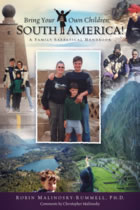Family-Friendly Spanish Schools in Latin America
Choose the Ones that Are Best for Everyone
by Robin Malinosky-Rummell
|
|
|
A beach in Panama can make for a great setting to practice and enjoy family Spanish language learning.
|
Latin America is becoming increasingly popular for family travel because of its proximity to the U.S. and reasonable prices. Hundreds of interesting language courses can be found via the Internet or in guidebooks, so how
does one go about selecting the best option? By the age of 10, my son Christopher has attended Spanish lessons in five different Latin American countries, located in places ranging from sandy beaches to historic colonial towns to verdant rainforests.
Through our journeys together we have found ways to help you find the right Spanish school for your family.
First and most importantly, make sure the school is in a location that you will all enjoy. Are you looking forward to a relaxing vacation spot on the sunny Caribbean coastline, or is your active family searching for adventure
in the jungle? At this stage of planning it is important to discuss everyone’s interests and goals and plan your trip based on your children’s abilities and limitations.
Language classes are the best introduction to a foreign country. You can learn about the local culture and obtain valuable information about kid-friendly sights and activities from your teacher, homestay family, and other
students. Your ear can grow accustomed to the local dialect and slang phrases.
When it comes to accommodations, think carefully about the type of experience you want. Be realistic. Homestays can be an inexpensive option that provides immediate social support and cultural immersion. In colonial Sucre,
Bolivia, the very welcoming Mama Vicky Hernais arranged in-home Spanish lessons for me and my husband, leaving Christopher free to join us or play with the other children there. In Panama I gained valuable professional insights from my delightful
host mother, who also works in the field of education. Even so, I find it essential to build in some quiet time alone with my son every day. Therefore I chose to stay in a “casita” at San Jose el Viejo in Antigua, Guatemala. After
a challenging day of Spanish lessons, we were able to prepare our meals and relax in our own apartment located directly on the school grounds.
For kids, Spanish lessons must be fun. If the classes aren’t enjoyable for your children, they may not be worth the investment. Christopher prefers structured activities for groups of children as opposed to one-on-one
instruction. Check out other childcare options. Perhaps your children would prefer to stay home and play with the host family kids.
Ask a lot of questions about your own classes. How do you learn best? Do you want some structured tutoring on basic grammar, or conversational practice? Communicate your needs to the school and your teacher in advance. If
possible, look at the materials. Talk to former students and find out what their classes were like. The school should be able to provide a list of references upon request.
Consider the time of day your family would like to take classes. Morning classes are most popular; they free up the rest of the day to explore the town. Schools often offer discounts on afternoon classes, which may be very
appealing if your family likes sleeping in. Make sure to align your class time with your children’s schedule and avoid conflicts with the school’s extracurricular activities.
Many schools now offer a variety of activities in addition to the Spanish classes. They are often much cheaper than those you could arrange on your own, and they give you more language practice in addition to a fun experience.
Investigate the school’s extracurricular offerings. If you are staying with a family, there will be naturally occurring times to socialize already built into your day. Some schools provide opportunities for volunteering. Before committing,
ensure that your children are truly up to the task and that you are willing to pick up the slack for them. Most importantly, give yourself and your family lots of time for rest and recreation. This is your vacation. Make the most of it!
Comparison of Recommended Language Schools
|
Spanish Schools
|
Location/ Airport Pickup
|
Accommodations
|
Class size/type
|
Children’s Program
|
Recommended Activities
|
CPI Spanish School in Costa Rica,
Has 3 locations: Monteverde, Heredia, and Flamingo.
|
Monteverde is a tiny town in the rainforest. Transportation available to all sites.
|
Homestay. Other options available at other sites.
|
Small group.
|
Excellent small group classes for children and teens. Pool table and ping pong available at the school.
|
Offers lots of fun family activities. Zip lines through forest canopy: Monteverde Cheese Factory tour, frog museum, snake museum, cooking class.
|
San Jose el Viejo,
Antigua, Guatemala
|
Beautiful colonial town, small enough to walk everywhere. Airport transport available from capital ( San Jose).
|
“Casitas,” private apartments on lovely grounds with gardens, game room, pool, and tennis court (bring your own rackets). Homestay options.
|
Private lessons include outing to nearby weaving cooperative in San Antonio Aguas Calientes.
|
Private lessons for kids include playing ping pong and foosball.
|
Can help you organize activities. Weekend day hike to see active volcano Pacaya; tour of nearby coffee plantation, Finca Filadelfia; Paseo de los Museos at the Casa Santo Domingo.
|

|
Robin Malinosky-Rummell, Ph.D., is a psychologist based in Oregon. She has visited more than 60 countries and spent a year traveling and volunteering with her husband and
son throughout South America.
|
|
